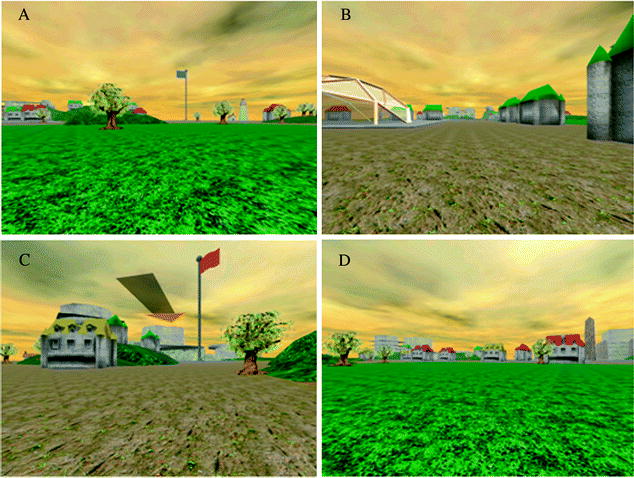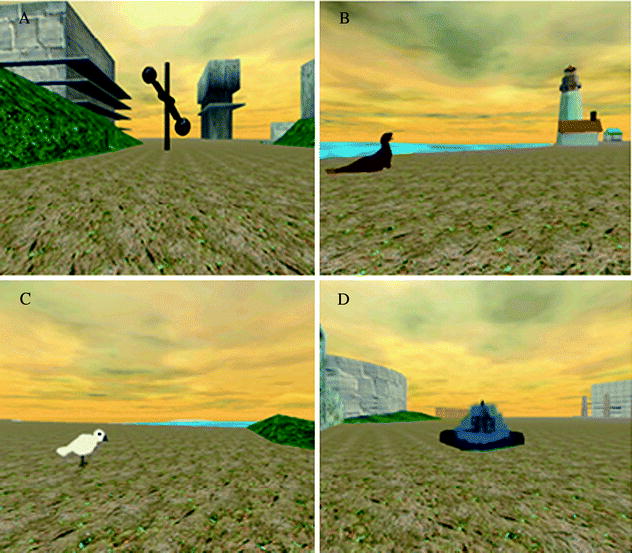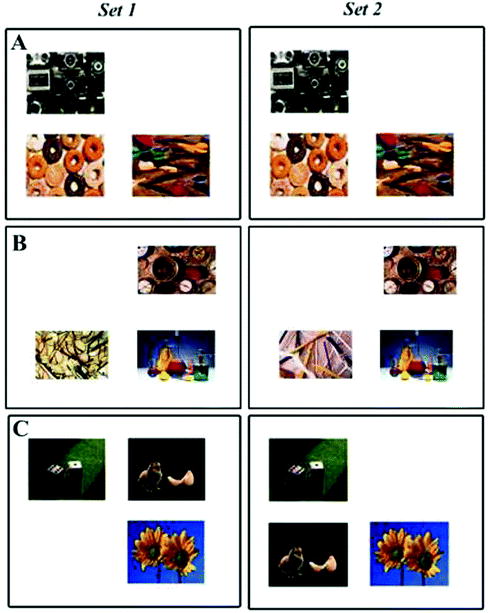Percentage of
spatial search
Percentage of
serial search
Percentage of
random search
First 1/2 of initial trials
36.6 ± 6.0
54.4 ± 5.6
9.1 ± 2.0
Last 1/2 of initial trials
62.0 ± 6.2a,b
34.3 ± 6.1
3.6 ± 1.2
First 1/2 of shift trials
28.9 ± 7.1
60.5 ± 6.9b
10.3 ± 2.9
Last 1/2 of shift trials
51.4 ± 5.9a
44.7 ± 6.1
5.5 ± 1.5
1.3 Human Testing
Traditional tests of spatial memory in humans are the Spatial Span Forward and Spatial Span Backward tests (34). These tasks use a series of ten blocks glued to a plastic tray on a tabletop. The experimenter “taps” the blocks in a specific order, increasing the number of blocks tapped in each trial. The subject is then asked to tap the blocks in the same order. The complexity increases until the person is unable to recall the order. Although these tests are challenging, they have a different design compared to traditionally spatial learning and memory tasks used in rodents.
Similar to nonhuman primate studies, most human neuropsychological testing does not involve navigation. While this issue is partly due to a lack of space, recent technological advances allow tasks with navigation. Computerized virtual reality training modules have been developed for this purpose. Such training modules are utilized for teaching skills such as driving or flying an airplane. In the clinical setting, computerized modules have been created to desensitize people, especially with post-traumatic stress syndrome and phobias (35–38). In addition, virtual reality mazes can be useful to test spatial learning and memory requiring navigation in humans. For instance, a virtual water maze for humans based on the rodent water maze has been developed (39). Results generated using the virtual water maze for humans does parallel results generated using the rodent water maze (39, 40). It should be kept in mind that in the virtual water maze there is a different motivation than the one in the water maze used in rodents.
Neurobiological networks of learning and memory in the human brain are often studied through case studies. Perhaps the most famous neuroscience patient is H.M., notable from the removal of his medial temporal lobe as a result of treatment for epilepsy (41). Although the removal of the brain tissue did alleviate the seizures, H.M. had major cognitive deficits. Interestingly, not all of his cognitive capabilities were affected; rather, it appeared that it was isolated to his declarative memory. Declarative memory consists of episodic and semantic memory or knowledge of “facts.” These types of memory include personal facts, history (cultural and personal), objects, and words. Episodic memory is the recollection of events that occur in a given time period. On the other hand, semantic memory is general knowledge accrued over time without being related to specific experiences. It is important to realize that these memories overlap and share common information. Moreover, each person has a unique episodic and semantic memory. Therefore, object recognition tasks were developed to standardize the cognitive paradigm.
Based on results from human studies including H.M. observations, declarative memory is hypothesized to be dependent on the hippocampus, but some debate remains on the way to effectively test episodic and semantic memory. Supporting the results from studying H.M., animal models of lesions of the hippocampus have demonstrated that disruption of the hippocampus can alter performance on object recognition tests. Furthermore, performance on object recognition tests is dependent on the extent and location of the lesion (42, 43).
Object recognition tests for human testing have undergone an evolution from 3D object recognition to simply visual object recognition, and participants are asked to generate a “snapshot” of an image. Object recognition tests are different from another popular test for human neuropsychological paradigms, the facial recognition test. Unlike the hippocampus-dependent object recognition, facial recognition tests are targeting a different area of the brain, the fusiform gyrus, which is in close proximity to but not encompassed within the hippocampus structure (44). Therefore, facial recognition tests and object recognition are separated into different tests in order to identify function of distinct areas of the brain.
To address which neural pathways are involved in performing different human cognitive tasks, functional magnetic resonance imaging (fMRI) can be used. Thus far, imaging studies in humans have corroborated the findings from the H.M. case study and indicate that object recognition tests differentially affect the hippocampus (45). Moreover, human imaging studies support that the neural pathways involved in facial recognition are different from those involved in object recognition (46). fMRI is not only a valuable to study cognition in humans but also to study cognition in nonhuman primates (47).
1.4 Sex Differences
One important consideration in studying spatial learning and memory is the sensitivity to gonadal steroids; the hippocampus is particularly sensitive to such effects. Not only have studies demonstrated that there is a morphological difference between the male and female hippocampus (48–50), but there is also a difference at the cellular electrophysiological level; males show a greater excitability than females (51). Furthermore, synaptic plasticity, including LTP, is different between the sexes, with males having greater synaptic plasticity than females (52). As such, it is not surprising that effects of sex are observed in object recognition and spatial learning and memory requiring navigation in animals as well as humans (53–57), further supported by imaging studies (58, 59). For instance, castration decreases spatial memory in wild-type mice (60), but androgen treatment recovers performance in males and increases performance in old female mice (61, 62). Furthermore, in mice expressing human apoE4, performance on spatial memory tests is improved with androgen treatment (testosterone or dihydrotestosterone) (63) and with selective androgen receptor modulators (SARMs) treatment (64). Increased efforts are warranted to understand the influence of sex hormones on spatial learning and memory requiring navigation and object recognition across species.
1.5 Implications for Translational Research
Traditionally, translational efforts of spatial learning and memory requiring navigation have been relatively unsuccessful, mostly due to the nonhomologous neural systems tested. Because of the discrepancies in the design of spatial learning and memory tests between rodents, nonhuman primates, and humans, few parallels have been made across species. Not surprisingly, most data on spatial learning and memory requiring navigation have been generated in rodent models. However, the addition of new spatial learning and memory tests for nonhuman primates and humans in recent years will allow more comparisons with rodent models. This in turn helps our understanding of spatial learning and memory requiring navigation across species in health and disease.
In Section 2, we describe two new test designs that enable cross-species comparison of object recognition and spatial learning and memory requiring navigation between rodents, nonhuman primate, and humans. Protocols for Memory Island, a human spatial learning and memory test, and Novel Image Novel location, a human object recognition test, will be highlighted, described, and discussed in detail.
2 Methods
In any cognitive paradigm, three phases of testing should be considered; habituation, training, and testing. Habituation is necessary to familiarize the subject with the testing arena, since the testing arena is usually outside the home environment. A training phase allows the subject to learn the task. Finally testing determines how well the subject learned the task and the efficacy of the cognitive function of interest. These phases ensure that the outcome of the test is appropriate and allows for interpretable results.
2.1 Habituation
Habituation, a process of learning in which a subject stops responding when repeatedly presented with a stimulus (65), is an important part of cognitive testing paradigms. For example, testing paradigms place subjects in unfamiliar situations and if as a result of this novelty they have increased measures of anxiety that might increase performance on the test. Multiple studies suggest stress-inducing anxiety or anxiety-like behaviors can decrease cognitive function. Therefore, it is important for the subjects to not feel overly anxious about the task and to be relatively relaxed when tested. The necessary time for habituation ranges depending on the paradigm and subject, and the range should be predetermined experimentally for each experiment.
2.2 Training
The training phase of a testing paradigm should allow sufficient time for subjects to learn the task. There can be a standard number of trials or subjects can be trained to perform to a certain criterion level. Once the subject has demonstrated learning of the task, testing performance can be assessed.
2.3 Testing
The testing phase involves the knowledge previously acquired during the training phase to determine how well the test was learned. This is the key phase that is often reported in literature, but the foundation of the habituation and training phases must be included and described for proper interpretation of cognitive test performance.
2.4 New Human Tasks for Cross-species Comparison
2.4.1 Spatial Learning and Memory (Memory Island)
Spatial memory tests for humans similar to those used in rodent models have been few in number due to the differences in the size requirements of the testing environments. Manipulation of an environment for 30 g mouse is obviously much easier than manipulation of an environment for a much larger and heavier 60 kg human. For example, if a test were developed with similar dimensions as the mouse water maze (tub diameter: 141 cm) for a human, the tub of water would need to be 3.2 km in diameter, which is not practical! An alternative is using virtual reality computer technology, which has revolutionized the ability to develop spatial learning and memory tests for humans using navigation without requiring a large arena. The virtual water maze for humans holds translational capabilities, as does the more entertaining and immersive spatial learning and memory test in humans involving navigation of a virtual island environment, Memory Island (13, 66). A key feature of Memory Island, seen in Fig. 4.1, is the various cues and distinct landmarks that offer the subject orientation within the island. A Memory Island testing paradigm is described below:


1.
Participants are placed in front of a 19-inch computer monitor with a stereo speaker and subwoofer.
2.
Using a joystick, participants are trained to navigate through the virtual world simulating an island environment of 347 × 287 m2 and for analysis composed of four quadrants containing a unique target item (Fig. 4.2). A computer-generated coordinate file is used to calculate the before-described outcome measures.
3.
In the first four trials, subjects are trained to navigate to clearly visible target items, one in each quadrant. In these “visible” trials, each target item is marked with a flag that is clearly visible from the distance. Starting orientation is varied for the four trials but kept the same across all participants. If the target is not located within 2 min, a directional arrow appears on the screen to guide the participant to the target (Fig. 4.1c).
4.
Once all four visible target items have been located, the subject is trained to locate a hidden target (no flag).
5.
The starting orientation is varied for each trial but kept the same for all participants. If the target has not been located within 2 min, a directional arrow appears on the screen to guide the participant to the target.
6.
After a delay (5–90 min) the subject is asked to locate the item in a “probe” trial (no target or flag).

Fig. 4.1.
View of Memory Island through screen shots of the virtual reality maze. Image a is from the start point, directed toward a flag marking the location of one of the target items during a visible trial, observed next to a lighthouse. Panel b is an image of the glass structure, a unique structure in quadrant 1. Image c shows the arrow that will appear if subjects are having difficulty finding the visible or hidden target. The arrow appears 2 min after the start of the trial and points in the direction of the target. Image d is a view of quadrant 3 from the starting location.

Fig. 4.2.
Screen shots of the target items in Memory Island: image a, black moving statue, quadrant 1; image b, seal, quadrant 2; image c, seagull, quadrant 3; image d, water fountain, quadrant 4.
2.4.1.1 Data Analysis
For each trial, the computer software program records a time-stamped coordinate file. The parameters that are recorded during acquisition allow for calculation of total distance moved (virtual feet), velocity (virtual feet per second), latency (seconds), cumulative distance to the target (virtual feet), and percentage time spent in the target quadrant. If the subject locates the target item within 2 min the trial is deemed a success.
For statistical analyses of outcome measures of Memory Island, ANOVAs, ANCOVAs, and Mann–Whitney U tests can be used (13). Performance on Memory Island can also be used to assess potential correlations with performance measures on other cognitive tests using Pearson or Spearman correlations.
2.4.2 Object Recognition (Novel Image Novel Location)
Based on the Novel Object Novel Location test developed in the mice, a similar Novel Image Novel Location (NINL) test has been developed for human testing, which is described in detail here:
1.
Three sets of 12 panels are shown, each containing 3 images. The two sets of three-image panels are similar in complexity, but different in content and arrangement within the four quadrants of the panel.
2.
Before beginning the training phase, the study participants are given an example of the test (habituation).
3.
For the training phase of the study, the first set of 12 panels is presented. Each panel is presented for 8 s. The study participant is asked to memorize the panels. Examples of the panel layout for no change, novel image, and novel location are shown in Fig. 4.3.
4.
In the testing phase of the study, the second set is presented. The testing set contains panels either identical or slightly changed compared to the reference set by containing one novel image or one image in a novel location. The subject is asked to identify if the panel is identical to or changed compared to the original panel. Then, if a change is indicated, the subject is asked to identify the type of change and where the change occurred. In this set, four panels are identical to the reference set, four panels have one image replaced with a novel image, and four panels have identical images with one image moved to a novel location.
5.
Following a delay period (5–90 min in length) and without seeing the training set again, the study participants are presented with a third set of 12 panels. Once again, the subjects are asked to identify the same criteria as in the first testing set, making reference back to the original reference set. The third set is identical to the second set but the order of the panels is rearranged.

Fig. 4.3.
Examples of the panels used in the Novel Image Novel Location (NINL) test. The left panels (Set 1) are examples from the reference set, the set that the subjects are presented first and asked to memorize. The right panels (Set 2) are examples from the test set. Panels in row a are an example of a set of “no change” panels. Panels in row b are an example of “novel image”’ panels. Panels in row c are an example of “novel location.”
2.4.2.1 Data Analysis
To score NINL test performance, a point system is used. Score sheets record responses of the subjects, i.e., no change, novel image, or novel location. In order to score a point, the subject has to correctly identify if there was a change, the type of change (novel image or novel location), and where the change occurred (quadrant of panel). A maximum total of 12 points is possible for both the immediate (first testing set) and delayed (second testing set). In addition to the total score, subscores are analyzed with a total of 4 points each for the no change, novel image, and novel location conditions.
NINL scores can be analyzed with one-way ANOVAs and correlations between NINL scores and subscores and other behavioral measures.
3 Notes
3.1 Memory Island
1.
Memory Island is a computerized task. Those individuals who have not been previously exposed to computerized graphics may be wary of the graphics or intimidated by the computer-based task. Some people with vertigo type symptoms or those easy to motion sickness might not be willing to perform the task. If the researcher suggests to the subject to watch the distant scenery instead of the immediate path, it can decrease potential unpleasant emotions. In our experience, these potential issues hardly occur in adult, elderly, or children.
2.




Although children appear to be very efficient at using the joystick, older generations, or those without previous exposure to using joysticks, might not be as predisposed to use the joystick effectively. Thorough explanation of the use of the joystick helps if this is a concern. Also, aiding in joystick direction during the first visible trial can increase the confidence and performance of the subject. Therefore, in some studies it is important to include data on pertinent computer use.
< div class='tao-gold-member'>
Only gold members can continue reading. Log In or Register to continue
Stay updated, free articles. Join our Telegram channel

Full access? Get Clinical Tree


